![]()
Aroids and other genera in the Collection
Take the Tour Now?
Orchids
The
Exotic Rainforest
Plants in
the Exotic Rainforest Collection
Images on this website are copyright protected. Contact us before attempting to reuse.
In depth information on how to grow Philodendron species, Click this Link
Within our collection we have many species of Philodendron. If you are seeking other photos, click this link
Philodendron mamei
André
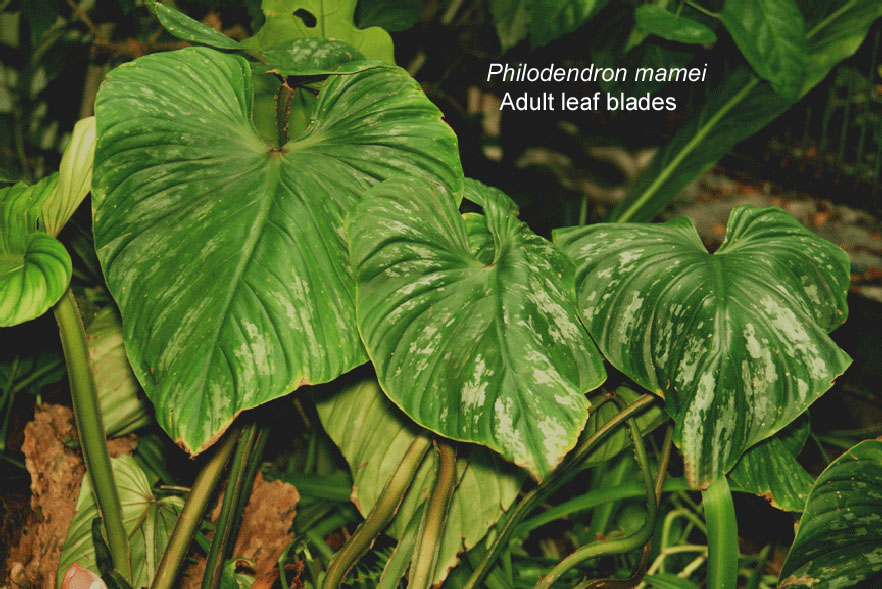
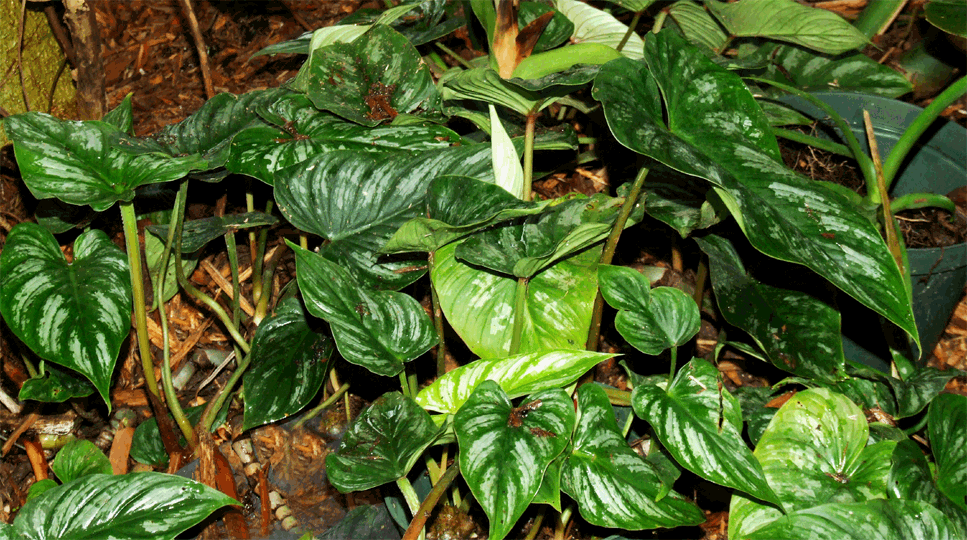
Philodendron mamei
André
A Creeping Aroid
Although
scientific terminology can be found in this text, an effort is made to
explain those terms in a way any
plant collector can use the information
to positively identify and better understand a specimen.
Identified to science in
1883, According to the published field notes of aroid botanist Dr.
Thomas B. Croat
Ph.D., P.A.
Schulze Curator of Botany
of the Missouri
Botanical Garden in St. Louis Philodendron mamei is a creeping
species
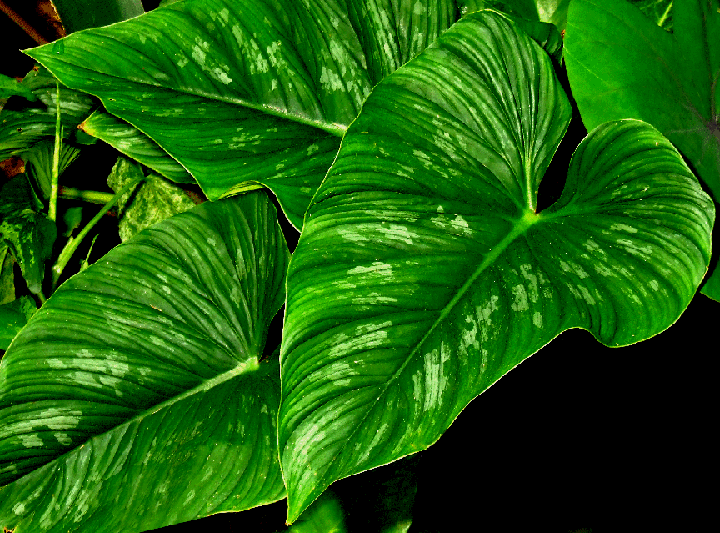 that grows
over the ground. To a botanist, such a creeping plant species is known
as being "repent", however,
Philodendron
mamei has been infrequently observed by field botanists growing as
an epiphyte (ep-a-FIT). And epiphytic species is one that grows upon another
plant, normally a tree.
that grows
over the ground. To a botanist, such a creeping plant species is known
as being "repent", however,
Philodendron
mamei has been infrequently observed by field botanists growing as
an epiphyte (ep-a-FIT). And epiphytic species is one that grows upon another
plant, normally a tree.
Since Philodendron mamei is a terrestrial species it is commonly found on steep banks with its caudex found creeping across the surface. The caudex is the main stem which may be woody and thickened in mature specimens. In botany the stem is not the support for any single leaf as is often thought by collector/growers, but instead is the stem which is the base of the plant. The petioles which support the leaves grow from nodes along the stem's length. The internodes, which are the stem segments between two nodes, are short. On a fully mature specimen the stems can measure approximately 1 meter (3 feet) in length.
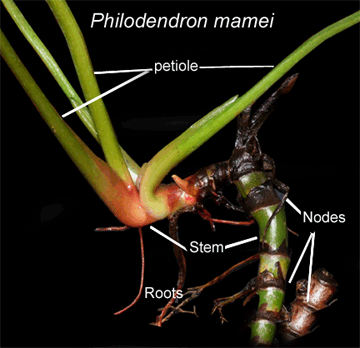 Near
the top of the petioles of Philodendron mamei (which are the
supports for each individual leaf, see illustration, right, for an
explanation of the location of the stem, petioles and nodes) are sub-terete
which means less than round and slightly flattened on the underside. The underside
of any plant surface is known as the abaxial surface while the upper
surface is known as the adaxial surface. The edges of the petioles
have an acute marginal rib. Anything in botany described as "acute" simply
means that part gradually tapers to a point. The petioles of
Philodendron mamei are medium to olive green in color with pale lines and are broadly convex
on the upper and lower surface. The petioles are striated which
means they have
grooves which run closely together along the petiole's surface. The petioles may
also be reddish near the base, Juvenile specimens of Philodendron
mamei may be
undulated (wavy) as well as possess a somewhat "D" shaped petiole.
The "D" shape can be observed if the
petiole is cut in half and viewed as a cross section.
Near
the top of the petioles of Philodendron mamei (which are the
supports for each individual leaf, see illustration, right, for an
explanation of the location of the stem, petioles and nodes) are sub-terete
which means less than round and slightly flattened on the underside. The underside
of any plant surface is known as the abaxial surface while the upper
surface is known as the adaxial surface. The edges of the petioles
have an acute marginal rib. Anything in botany described as "acute" simply
means that part gradually tapers to a point. The petioles of
Philodendron mamei are medium to olive green in color with pale lines and are broadly convex
on the upper and lower surface. The petioles are striated which
means they have
grooves which run closely together along the petiole's surface. The petioles may
also be reddish near the base, Juvenile specimens of Philodendron
mamei may be
undulated (wavy) as well as possess a somewhat "D" shaped petiole.
The "D" shape can be observed if the
petiole is cut in half and viewed as a cross section.
Philodendron mamei has been stated in some internet material to grow leaf blades up to 1 meter (3 feet) in width, however the average specimen will possess leaves of approximately 25 to 45cm (10 to 18 inches) in size depending on the care given to the specimen. The leaves of Philodendron mamei are thin and are scientifically considered to be sub-coriaceous which means less than leathery to the touch. The leaf blades are semi-glossy on the upper (adaxial) leaf surface.
If the underside of a leaf blade is examined the lower surface (abaxial)
will be seen to be much paler in color and only slightly glossy.
The mid-rib at the blade's center
is flat on the upper surface but is convex on the underside. The primary lateral
leaf veins of
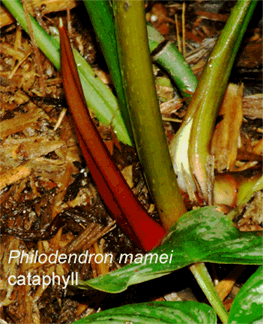 Philodendron mamei are sunken on the adaxial
(upper) surface but are convex on the underside while the minor veins
are only moderately visible
on the underside.
Philodendron mamei are sunken on the adaxial
(upper) surface but are convex on the underside while the minor veins
are only moderately visible
on the underside.
Once any new leaf is produced it
is surrounded by a sheath-like structure known in botany as a cataphyll
which in Philodendron mamei are reddish/brown in color.
The
cataphylls are bract like modified leaves that surround any new
leaf and whose purpose is to protect those emerging leaves
as they develop.
The cataphylls of Philodendron
mamei are 2 ribbed and remain somewhat intact once the new leaf is fully
developed. The cataphylls of P. mamei are
flattened as well as winged on the edges.
All Philodendron
species are aroids.
An
aroid is a plant that reproduces through the production of an inflorescence and the
major parts of that inflorescence are known as a spathe and spadix. Many
growers believe the spathe is a "flower"
but that is inaccurate since the
spathe is nothing more than a modified leaf
appearing to be a
hood
whose purpose
is to protect the spadix at its center. If you
explore the inflorescence with a strong magnifying glass when it
first reaches female anthesis (sexual reproduction) and is beginning to open you can find very tiny flowers (both
male, sterile male, and female) found on the spadix.
The female flowers are securely hidden inside the floral chamber at
the lower extreme of the spadix and are the first to open. If
the female flowers are pollinated with the pollen brought by an
appropriate insect from
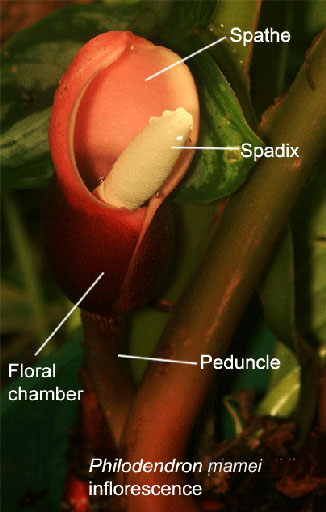 another specimen of Philodendron mamei
that
currently has the male flowers at male anthesis and producing pollen the spadix
will produce seeds. In Philodendron species pollination is almost
always done by a Cyclocephala beetle species of which there
are approximately 900 species (approximately one half are identified
to science), The illustration to the right is not the
inflorescence of Philodendron mamei and is used only to illustrate the parts
of a Philodendron inflorescence.
another specimen of Philodendron mamei
that
currently has the male flowers at male anthesis and producing pollen the spadix
will produce seeds. In Philodendron species pollination is almost
always done by a Cyclocephala beetle species of which there
are approximately 900 species (approximately one half are identified
to science), The illustration to the right is not the
inflorescence of Philodendron mamei and is used only to illustrate the parts
of a Philodendron inflorescence.
In Philodendron
mamei there are one to two inflorescences per axil on a specimen.
The spathe is supported by a stalk known as a peduncle which is normally
dark purple. The spathe is a medium olive green and is only
slightly glossy but is tinged with purple/violet
on the open side of spathe tube but may also be a dark violet purple
while the
inside of the spathe tube is a cream white. The spathe is striated (grooved)
near the base. Once the spathe is past sexual anthesis the spathe
may become a dark
violet purple on the tube.
For a more complete explanation of pollination in aroid species, please read this link: Aroid pollination
At one time Philodendron mamei was both rare and expensive but due to the use of "tissue culture" in plant propagation Philodendron mamei has become common. Tissue cultured plants do not necessarily achieve the size nor beauty of a wild collected specimen due to the chemical processes used in their cloning. Tissue culture is simply the cloning of another plant but the chemicals used are known to cause changes in the appearance, growth rate, and size of a specimen. Websites that claim to sell a "super sized" variation of this species are selling only a normal specimen (almost always cloned) of Philodendron mamei since the size of a specimen has nothing to do with a species' variation.
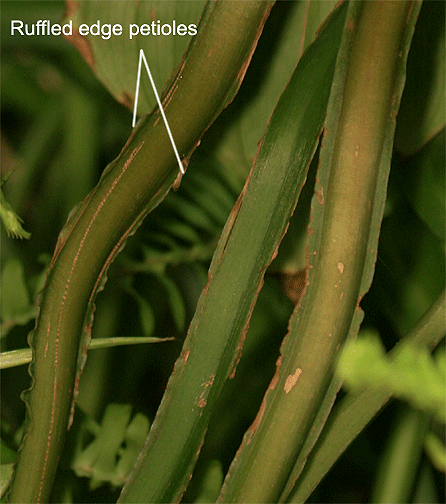 Philodendron
species are
known to be highly variable and not every leaf of every specimen
will always appear the same. This link explains in
non-technical language natural variation and
morphogenesis within aroids and other species.
Click
here.
Philodendron
species are
known to be highly variable and not every leaf of every specimen
will always appear the same. This link explains in
non-technical language natural variation and
morphogenesis within aroids and other species.
Click
here.
Philodendron mamei prefers bright but indirect sunlight and does not do well in temperatures much below 12.75 C (55 degrees F). If exposed to colder temperatures Philodendron mamei may simply stop growing, reduce in size or just vanish. A specimen should be planted in very fast draining soil that is kept evenly damp but never soggy.
The base information found in
this article was taken from the published field notes of aroid botanist
Dr. Thomas B. Croat Ph.D., P.A. Schulze Curator of Botany at the
Missouri Botanical Garden in St. Louis, MO, as well as from
TROPICOS, an on-line service of the Missouri Botanical Garden. All
photographs (unless otherwise noted) are the copyrighted property of
Steve Lucas,
www.ExoticRainforest.com
Photography Copyright 2008, Steve Lucas.
Aroid Pollination!
As
it occurs in nature and by any horticulturist
Specimens may be available from
Brian's Botanicals
http://www.briansbotanicals.net/

Want to learn more
about aroids?
Join the
International Aroid Society:
http://www.exoticrainforest.com/Join%20IAS.html